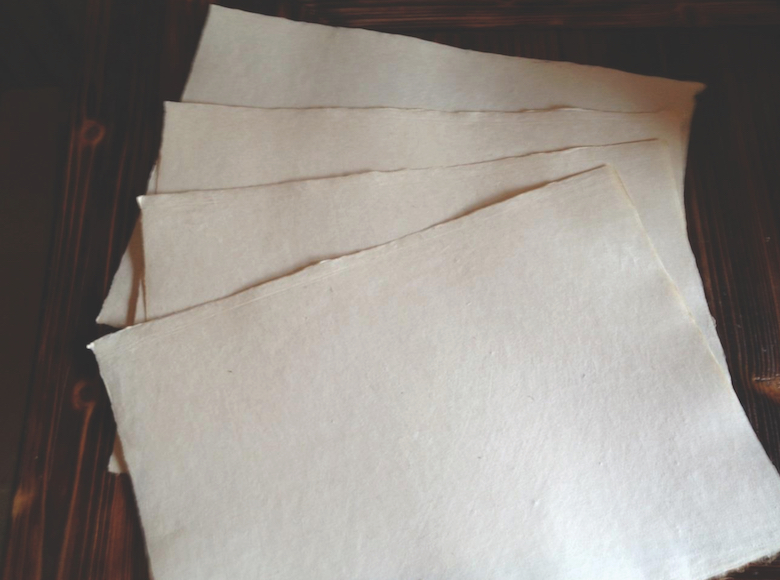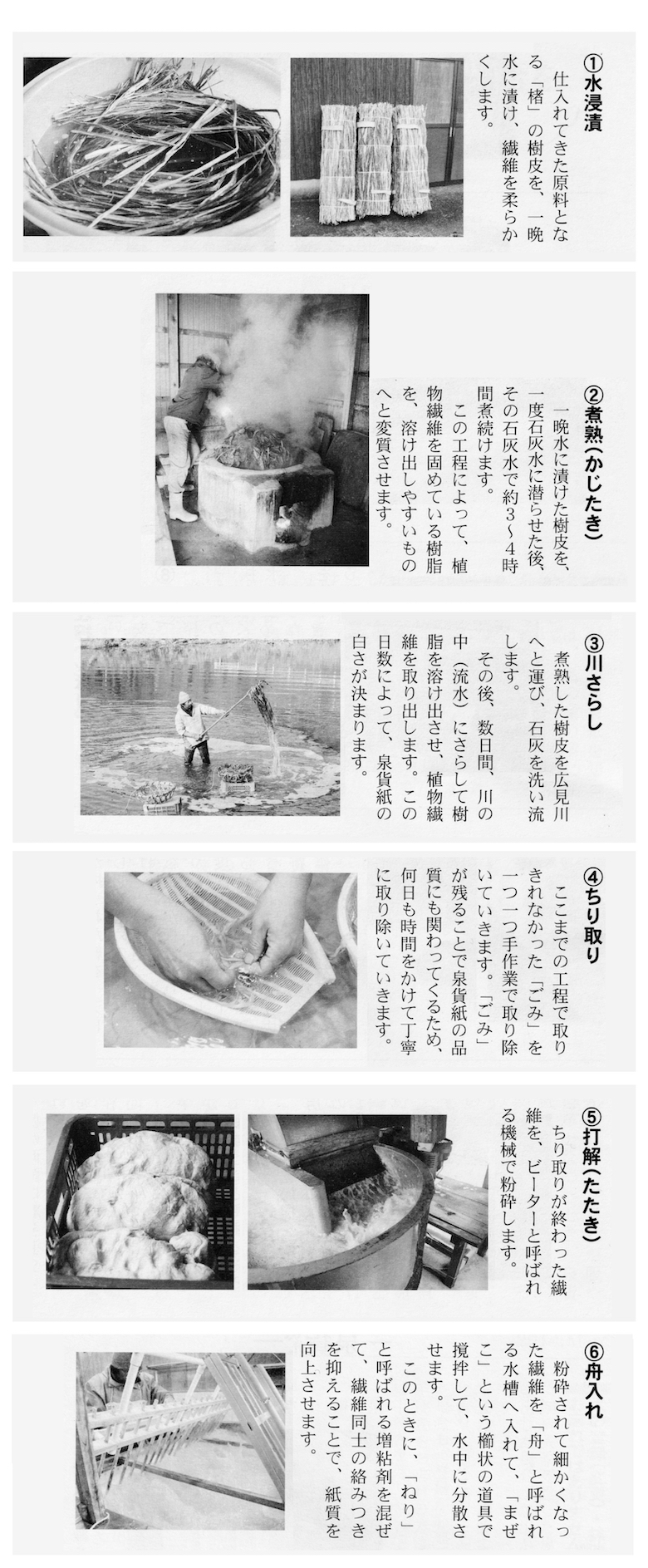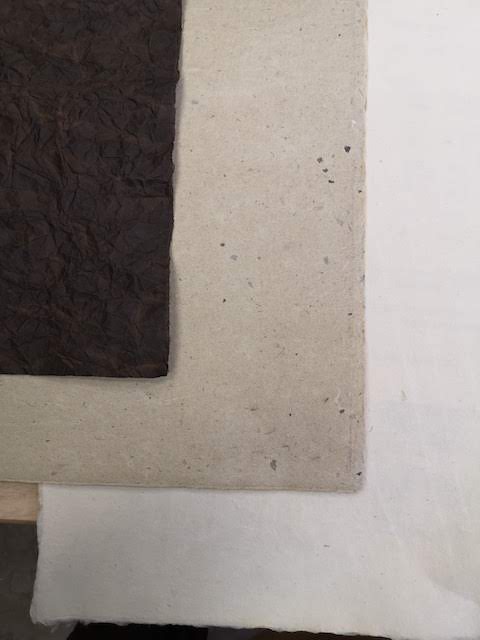“SENKA-SHI”
is a Japanese paper used for clothing as a substitute for cloth.
We continue to produce in accordance with the old-fashioned manufacturing method of “KAWA SARASHI” = natural bleaching and “ITA TUKE TENPI HOSHI” = Sun-dried on the wood board, and retain the world’s rare old-fashioned Japanese paper.


Senkashi is a famous Japanese paper, as listed in the Japanese dictionary. Japanese paper is called “washi” or “washi paper.”
Senkashi is said to have originated during the Tenshou Era (1573-1593) after the end of the Warring States period. Following the collapse of the Iyo-Saionji family, a military commander named Tarouemon Doi who served the family became a priest and retired to the current Anraku Temple in Nomura Town, Seiyo City in Ehime Prefecture, where he began to create the new washi paper. Other washi papers date back to the Heian (794-1192) and Kamakura (1192-1333) periods, and compared to them, Senkashi paper is a relatively young washi paper.
After that, the production of this washi paper was promoted as a business product of the Uwajima clan (and the Yoshida clan that was formed by the division), and Senkashi became a special product of Iyo-Uwajima. More than 100 years after his death, Tarouemon Doi was awarded in the paper industry by being honored the posthumous Buddhist name “Seizyoin Houzan Senka Koji.” The name of the paper “Senkashi” derives from this award.
Senkashi is made by a unique method in which one of the two wet sheets of paper, immediately after being lifted, is turned over and overlaid into one. It has excellent properties when used like cloth, such as for paper clothes and, in particular, paper treated with persimmon astringent, which has moisture-proof, antiseptic, and insect-repellent effects. It is also used as material for making equipment such as paper bags, rain gear, and paper containers.
From the end of the Edo (1603-1867) period to the beginning of the Meiji (1868-1912) era, there was a person in the village of Izumi (now Kihoku Town) in the Kitauwa District of Ehime Prefecture called Azechi Ruikichi, who added original improvements to the method of making Senkashi. He succeeded in creating extremely high quality paper. The paper became famous as “Ruikichi paper,” and his method was propagated and established in this area. The area around the village of Izumi in Kihoku Town (around the Oguwa District) will continue to develop into the largest source of Senkashi. Eventually, Ruikichi paper became known as “Oguwa Chuzen ” and was established as a brand of Senkashi.
In the Showa (1926-1989) era, the quantity of plastic industrial products increased sharply, so the industrial use of washi paper dramatically decreased, and the demand for thick paper was lost in Japan. Under such circumstances, abrasive material manufacturers found that Oguwa Chuzen paper had excellent industrial characteristics, and the production expanded as demand for sandpaper mounts increased. This was the main use of
post-war Senkashi, but eventually synthetic paper was used for the mount of sandpaper, and production of Senkashi was cut off in 1969.
In 1985, for the purpose of handing down the tradition and industrial science of Oguwa Chuzen, the Senkashi Preservation Society was formed by local volunteers, and washi paper production was restored. Washi paper making that preserves the old-fashioned manufacturing method is still being continued.


泉貨紙について
泉貨紙は国語辞典にも載っている有名な和紙です。
戦国時代末期の天正年間(1573~1593年)に伊予・西園寺家に仕えていた土居太郎右衛門という武将が西園寺家滅亡の後、出家・隠遁して現在の愛媛県 西予市 野村町の安楽寺にて厚紙を漉き始めたのが起源であると伝えられています。他産地の和紙には、始まりが平安・鎌倉期まで遡るものも珍しくはなく、それらと比べると、泉貨紙は比較的歴史の浅い和紙と言えます。
その後、宇和島藩(および分領してできた吉田藩)の殖産事業として和紙生産が奨励され、泉貨紙は伊予・宇和島の特産品となります。土居太郎右衛門には、没後百年以上を経てから、「清浄院宝山泉貨居士」という法号が追賞され、紙業の顕彰がなされました。「泉貨紙」という紙の名前はこの顕彰を由来としています。
泉貨紙は、漉き上がった直後の濡れた2枚の紙の片方を反転させて重ね合わせて1枚にするという独特の製法で作られます。紙衣など布のような使われ方において優れた特性を有し、特に柿渋処理を施した渋紙には、防湿、防腐、防虫の効果があり、紙袋、雨具、紙器など用具製作のための工芸工作用紙として使用されます。
幕末から明治初期にかけて、愛媛県北宇和郡泉村(現・鬼北町)に畔地類吉(あぜち・るいきち)という人物があって、これまでの泉貨紙の製法に独自の改良を加え、極めて高い品質の泉貨紙を作り出すことに成功します。その泉貨紙は「類吉紙」(るいきちがみ)として有名になり、彼の手法はこの地域内に伝播され定着し、鬼北の泉村周辺(小倉地区を中心とする一帯)は、泉貨紙の最大産地に発展していきます。やがて、類吉紙は「小倉仲仙紙」(おぐわちゅうぜんし)とも呼ばれるようになって泉貨紙のブランドを確立するに至ります。
昭和期になるとプラスティック工業製品が急増して和紙の工芸用途は激減し、厚楮紙の需用が全国的に失われていきます。そうした時勢にあって、小倉仲仙紙の工業的特性が優れていることが研磨材メーカーから見出され、サンドペーパーの台紙としての需用を得て生産が拡大します。これが戦後の泉貨紙の主用途となりましたが、やがてサンドペーパーの台紙にも工業合成紙が用いられるようになり、1969年を最後に泉貨紙は生産が途絶えてしまいます。
1985年、「小倉仲仙紙」の生産技術を伝承する目的で、地元有志により「泉貨紙保存会」が結成され和紙生産が復活しました。古式製法を守った和紙作りが今も続けられています。
鬼北泉貨紙保存会
